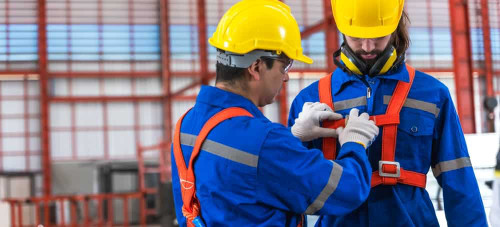The Importance of Fall Protection Training
In the construction industry, the difference between life and death can often come down to proper training. Nowhere is this more evident than in the realm of fall protection. Falls remain the leading cause of death in construction, accounting for over a third of all fatalities in the industry. This sobering statistic underscores the critical importance of fall protection training for every construction worker.
Why Fall Protection Training Matters
1. It Saves Lives
The most obvious and important reason for fall protection training is its potential to save lives. Proper training equips workers with the knowledge and skills to:
- Identify fall hazards
- Properly use fall protection equipment
- Understand and implement fall prevention strategies
When workers are well-trained, they're less likely to take unnecessary risks and more likely to use safety equipment correctly.
2. It's Required by Law
OSHA mandates that employers provide fall protection training to workers who might be exposed to fall hazards. This training must be conducted by a competent person and cover topics such as:
- The nature of fall hazards in the work area
- The correct procedures for erecting, maintaining, and disassembling fall protection systems
- The proper use and operation of guardrail systems, personal fall arrest systems, safety net systems, warning line systems, safety monitoring systems, controlled access zones, and other protection
Failure to provide this training can result in significant fines and legal liabilities for employers.
3. It Increases Productivity
While safety is the primary concern, well-trained workers are also more productive. When employees feel confident in their ability to work safely at heights, they can focus on their tasks without constant worry about falls. This leads to more efficient work and fewer delays due to safety concerns.
4. It Fosters a Culture of Safety
Regular and comprehensive fall protection training helps create a culture of safety on construction sites. When workers see that their employer is invested in their well-being, they're more likely to take safety seriously and look out for their colleagues as well.
Key Components of Fall Protection Training
Effective fall protection training should cover several crucial areas:
1. Hazard Recognition
Workers need to be able to identify potential fall hazards in their work environment. This includes recognizing:
- Unprotected edges
- Holes and openings in floors and walls
- Unstable working surfaces
- Improperly constructed scaffolding
2. Equipment Use and Inspection
Training should cover the proper use, care, and inspection of fall protection equipment, including:
- Full-body harnesses
- Lanyards and lifelines
- Anchor points
- Guardrail systems
- Safety nets
Workers should know how to inspect their equipment before each use and recognize signs of wear or damage.
3. Fall Protection Systems
Understanding different fall protection systems and when to use them is crucial. Training should cover:
- Personal fall arrest systems
- Guardrail systems
- Safety net systems
- Warning line systems
- Controlled access zones
4. Rescue Procedures
In the event of a fall, quick and effective rescue can mean the difference between life and death. Workers should be trained in:
- Self-rescue techniques
- Assisted rescue procedures
- The importance of prompt rescue to prevent suspension trauma
5. Regulations and Standards
While not the most exciting part of training, understanding relevant OSHA regulations and industry standards is important. This knowledge helps workers understand the "why" behind safety procedures and can lead to better compliance.
The Role of Hands-On Training
While classroom instruction is important, hands-on training is crucial in fall protection. Practical exercises should include:
- Properly donning and adjusting a full-body harness
- Connecting and disconnecting from anchor points
- Setting up guardrail systems
- Simulated fall scenarios (in a controlled, safe environment)
This hands-on experience helps workers develop muscle memory and confidence in using fall protection equipment.
Ongoing Training and Refreshers
Fall protection training isn't a one-time event. Regular refresher courses are essential to:
- Reinforce important safety concepts
- Introduce new equipment or procedures
- Address any questions or concerns that have arisen on the job
- Comply with OSHA requirements for ongoing training
OSHA requires retraining when there are changes in the workplace, fall protection systems, or equipment that render previous training obsolete.
Conclusion
Fall protection training is not just a regulatory requirement—it's a moral imperative and a smart business practice. By investing in comprehensive and ongoing fall protection training, construction companies can save lives, improve productivity, and foster a culture of safety that benefits everyone on the job site.
Remember, in the world of construction, knowledge truly is power—the power to work safely, efficiently, and confidently at any height. So, whether you're a seasoned veteran or new to the industry, never underestimate the importance of fall protection training. It could be the most important lesson you ever learn on the job.

